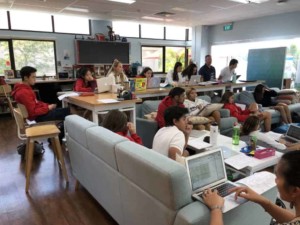Developing Leadership Qualities in the Classroom Through SEL

By Diana Clark
When teachers encourage students to work on team projects, they learn how to confront their ideas and resolve conflicts. In essence, they learn to collaborate and communicate. The practices that move learning toward that kind of cooperative mindset fall under the term social and emotional learning (SEL).
When a student enters the door of the classroom, they are not there solely for the knowledge they are supposed to gain. All of those lessons, terms, definitions, concepts, tests, quizzes and assignments have a hidden goal behind them: social-emotional development.
But did you know that this approach can help your students develop leadership skills, too?
How the SEL Process Leads to Improved Leadership Skills
- Communication Skills. This includes cooperation, problem-solving and listening skills. In addition, students learn how to deal with conflict situations.
- Social Awareness Skills. Students learn how to consider other peoples’ opinions and show empathy.
- Emotional Management Skills. The students learn how to manage stress and motivate themselves to work towards particular goals.
- Self-Awareness Skills. Throughout the process of collaborating, students learn how to identify and express their own feelings.
- Decision-Making Skills. When students work in a group, they have to make reasonable choices that everyone agrees with.
Did you recognize the leadership aspect in all these skills? A leader has to communicate, consider other people’s opinions, manage their own emotional response and make smart decisions. The SEL implementation process helps students develop those exact skills. You’ll be recognizing the leaders in the teams before you know it. Moreover, you’ll encourage all members of the teams to work on the skills that will turn them into future leaders.
Leadership Challenges: How to Respond to Them
How exactly can you implement social-emotional learning in the classroom in a way that supports leadership skills? You will come across several different challenges you’ll need to overcome, such as:
1. Transforming from “me” to “we:”
The traditional classroom setting grades students individually. When you’re promoting SEL, you are encouraging the students to consider the team’s success as their own. However, individualism has always been the main focus as they were growing up, so you will notice that some of the students will try to impose their opinions and authority. That is not a true leader’s attitude.
You can help them overcome this challenge by emphasizing the fact that you’ll be evaluating the team’s results. Every single member of the team will get the same grade for this project. Teach them how to delegate responsibilities. Monitor the way they communicate within the team and give them advice whenever necessary.
2. Designing projects in which teams develop a single final product?
The greatest leadership challenge is presenting a project the entire team has worked on. When you have a group of students working together, who will be the one to write the paper or presentation? There are few solutions to this problem:
- The team can work on a collaborative platform, such as Google Docs. They can all edit the document together.
- Each team member can write a specific part of the content. For example, if they are working on a project for history class, each can explore a different era. Then they can combine the parts in a unique presentation that you grade as a team project.
Working together allows students to collaborate on the specific project as a team. This can prevent them from using assignment help and improve the leadership skills they will need in the future.
3. Preventing conflicts from ruining the teams:
There will be conflicts in the teams. When individual students are asked to provide their opinions, you can expect differences. The point of SEL is to help students overcome those differences and come down to a common ground. That’s what good leadership is all about.
Pay attention to their decisions and look for patterns. Are some members of the team constantly being avoided or pushed away? What’s the reason for such an attitude? Try to engage the introvert students more in teamwork, and teach the overactive members to tone down their egos.
Social-Emotional Skills Lead to Intelligent Leadership
In leadership, emotional intelligence is extremely important. An authoritative leadership style is no longer effective. Once your students make the transition from the classroom to the real world, they will strive for leadership positions in different industries. These are the skills they will have to show:
- Self-awareness. First of all, the leader should always recognize and control their own emotions. They should understand how their actions affect the people around them. Leadership positions demand authority, but they also call for humility. By implementing SEL in the classroom, you teach your students to develop self-awareness skills.
- Accountability. When something goes wrong, a true leader doesn’t blame others. They make a commitment to admit their mistakes and face the consequences. Teamwork and collaboration activities teach your students how to feel responsibility for the input they have on the overall result.
- Self-motivation. This is an emotional skill that pushes successful leaders towards their goals. SEL activities in the classroom will be the first steps toward developing a strong ability for self-motivation.
- Collaboration A successful leader needs to showcase masterful collaboration skills. They know when to praise others and how to resolve conflict situations within the team through proper communication. Your classroom can be the place where they develop the foundation of this skill.
Before you can implement the SEL methodology in the classroom, you have to understand its vision. The point of this approach is to prepare students to develop soft skills that turn them into successful members of society.
It can be slightly challenging to align SEL activities with the Common Core Curriculum Standards, as they call for individual grading, but that just means you can’t view the students as groups all the time. However, you can still implement the social and emotional learning approach through specific projects and activities that bring your students together.
For more, see:
- How Dialogue Teaches Critical Thinking and Empathy
- Great Educators Teach the Whole Child: Integrating SEL in the Classroom
- Getting Smart Podcast | Building 21st-Century Skills
Diana Clark is a high-school educator from Philadelphia. Follow her on twitter: @DianaCl97652243
Stay in-the-know with all things EdTech and innovations in learning by signing up to receive the weekly Smart Update.







0 Comments
Leave a Comment
Your email address will not be published. All fields are required.